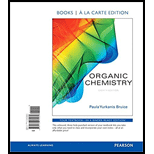
(a)
Interpretation:
Electrophiles and nucleophiles should be identified in the given
Concept introduction:
Nucleophiles are the electron rich species and it can share at least a pair of electron. Nucleophiles have negative charge.
Electrophiles are electron deficient species; they look for a pair of electrons. An electrophile has a positive charge, a partial positive charge or an incomplete octet that can accept electron.
(b)
Interpretation:
Electrophiles and nucleophiles should be identified in the given acid-base titration.
Concept introduction:
Nucleophiles are the electron rich species and it can share at least a pair of electron. Nucleophiles have negative charge.
Electrophiles are electron deficient species; they look for a pair of electrons. An electrophile has a positive charge, a partial positive charge or an incomplete octet that can accept electron.
Want to see the full answer?
Check out a sample textbook solution
Chapter 5 Solutions
ORGANIC CHEMISTRY (LL)-W/MOD.MASTERING.
- Which of the following can inhibit nitrification? 1. Low HNO2 2. High NH3 3. High NH4+ 4. pH < 5 5. Low HCO3- 6. High HNO2 7. High NO2arrow_forward1) Which reaction is likely to be more exergonic, one with Keq = 1000 or one with Keq = 0.001?arrow_forwardIn an SN2 reaction between 2-chlorobutane and iodide ion, what happens to the rate of the reaction if: (a) the concentration of 2-chlorobutane is doubled? (b) the concentration of iodide is doubled?arrow_forward
- a. Indicate how each of the following factors affects an E1 reaction: 1. the strength of the base 2. the concentration of the base 3. the solvent b. Indicate how each of the same factors affects an E2 reaction.arrow_forwardorganic chemistry 30) Which compound is the strongest acid?arrow_forwardWhat contributes to the deactivating nature of halides inelectrophilic aromatic substitution? a. inductive effect b. octet rule c. delocalization of electron pairarrow_forward
- Four of the seven steps in the mechanism for this process are shown in the conversion of acetal A to hemiacetal E. a.) Add curved arrows for each step b.) Draw another resonance structure for C.c.) Identify the nucleophile and electrophile in Step [3].d.) Which steps are Brønsted–Lowry acid–base reactions?arrow_forwardWhich of the following reactions represents the most likely reaction of naproxen with water? a.) C14H14O3(aq) + H2O(l) ⇄C14H13O3-(aq) + OH-(aq) b.) C14H14O3(aq) + H2O(l) ⇄C14H15O3+(aq) + OH-(aq) c.) C14H14O3(aq) + H2O(l) ⇄ C14H13O3-(aq) + H3O+(aq) d.) C14H14O3(aq) + H2O(l) ⇄C14H15O3+(aq) + H3O+(aq)arrow_forwardIn the first step of HBr addition to ethylene (H2C=CH2), which compound is the nucleophile? Options: H+ HBr ethylene Br-arrow_forward
- Given the following reaction sequence: What are the reagents for reaction 7? A) HBr 2 eq B) Br2arrow_forward19) Halohydrin formation from an alkene involves: a. Temporary induction of the dipole moment of a halogen gas.b. Electrophilic attack of pi electrons from the double bond.c. Formation of bromium anion.d. Formation of base as a final product.e. Attack of water molecule as a weak acid.arrow_forwardWhen methanitrobenzoic acid is reacted with bromomethane in the presence of Lewis acids, the product is: A. III No.B. V numbered structureC. Structure ID. Building IIE. Building IVarrow_forward
 ChemistryChemistryISBN:9781305957404Author:Steven S. Zumdahl, Susan A. Zumdahl, Donald J. DeCostePublisher:Cengage Learning
ChemistryChemistryISBN:9781305957404Author:Steven S. Zumdahl, Susan A. Zumdahl, Donald J. DeCostePublisher:Cengage Learning ChemistryChemistryISBN:9781259911156Author:Raymond Chang Dr., Jason Overby ProfessorPublisher:McGraw-Hill Education
ChemistryChemistryISBN:9781259911156Author:Raymond Chang Dr., Jason Overby ProfessorPublisher:McGraw-Hill Education Principles of Instrumental AnalysisChemistryISBN:9781305577213Author:Douglas A. Skoog, F. James Holler, Stanley R. CrouchPublisher:Cengage Learning
Principles of Instrumental AnalysisChemistryISBN:9781305577213Author:Douglas A. Skoog, F. James Holler, Stanley R. CrouchPublisher:Cengage Learning Organic ChemistryChemistryISBN:9780078021558Author:Janice Gorzynski Smith Dr.Publisher:McGraw-Hill Education
Organic ChemistryChemistryISBN:9780078021558Author:Janice Gorzynski Smith Dr.Publisher:McGraw-Hill Education Chemistry: Principles and ReactionsChemistryISBN:9781305079373Author:William L. Masterton, Cecile N. HurleyPublisher:Cengage Learning
Chemistry: Principles and ReactionsChemistryISBN:9781305079373Author:William L. Masterton, Cecile N. HurleyPublisher:Cengage Learning Elementary Principles of Chemical Processes, Bind...ChemistryISBN:9781118431221Author:Richard M. Felder, Ronald W. Rousseau, Lisa G. BullardPublisher:WILEY
Elementary Principles of Chemical Processes, Bind...ChemistryISBN:9781118431221Author:Richard M. Felder, Ronald W. Rousseau, Lisa G. BullardPublisher:WILEY





